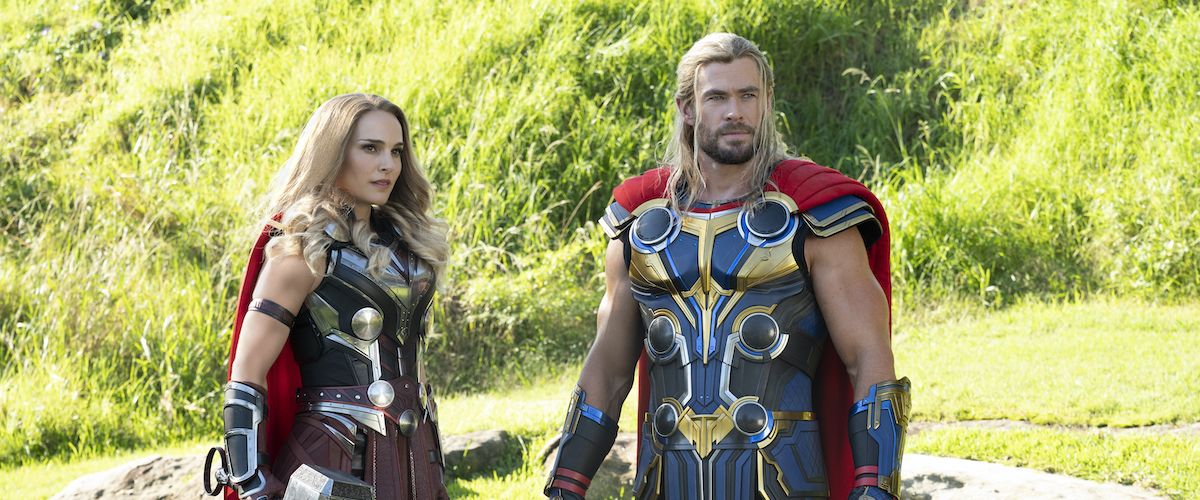By Jonah Naplan
July 7, 2022

Review: Attempts at silliness and humor are high in 'Thor: Love and Thunder,' director Taika Waititi's latest creative endeavor.

By Jonah Naplan
July 7, 2022

“Thor: Love and Thunder” is very silly, and for the most part that’s actually a good thing. The film’s many instances of screaming goats, for example, (you’ll know when you see it) made me crack up harder than they probably should. See, this movie provides my kind of humor. I can appreciate serious movies, sad movies, thrilling movies, and even intelligent comedy flicks, but every once in a while it feels really good to sit back in a leather movie theater recliner and enjoy silly and dumb entertainment, especially when it involves comic book characters we’ve been watching for over a dozen years, flashy and creative action setpieces, and Christian Bale as Gorr the God Butcher. Taika Waititi’s film has all of that. It’s not perfect, but Waititi certainly directs with love, and shoots the film with thunder.
At the time this movie takes place, New Asgard is booming. They’re a thriving community of people led by King Valkyrie (Tessa Thompson), sporting a “Phantom of the Opera” T-shirt and an all business attitude. New Asgard has become a tourist attraction, with rollercoasters and Infinity Stone themed ice cream shops. But meanwhile, Thor is off with the Guardians of the Galaxy, and in his first scene, he says goodbye to them. As much as I love those characters, they’re gone in nearly an instant. Thor returns back to his home, and joins a brutal battle once a new threat emerges: bald Christian Bale.
The villain’s exposition is established early on. We learn about the death of Gorr’s daughter, his grief surrounding the tragedy, and how it plays into his lethal motivations. Gorr is selected by the Necrosword, a powerful weapon that assists him in creating black rampant creatures. (I would have asked to look at these creatures’ IDs if I were a main character in this movie, because they’re completely unidentifiable. Said creatures just look like blobs. They probably couldn’t apply for a driver’s license either.) Gorr’s objective: obliterating every god known to man, starting with the ones who ignored his pleas for help, and then moving on to Thor, and really anyone else he could have encountered along the way. I read a synopsis this morning that described Gorr as a “non-believer.” It was apparently his lack of belief that fueled his vengeance towards the gods. I actually disagree. My feeling is that Gorr would have done anything to bring his opposers to justice regarding his daughter whom he clearly cared about. He wasn’t on a blood-thirsty, god-killing rampage just for fun or because he decided not to believe in their power anymore, rather he felt it would give him consolidation after his daughter, and assumedly other loved ones, were killed. Murdering gods may have just been an uplifting Tuesday afternoon activity for him. Maybe it gave him a new feeling of power. Maybe killing gods gave him confidence. Man, I never thought I would use the words “killing gods” and “confidence” in the same sentence. Thank you, Taika.
But as much as I loved Christian Bale in this movie, and how he chewed up the scenery in each moment he was on-screen, I thought his time in the film was significantly too short. He appears a handful of times in the first act, a lot in the messy third act, but then disappears entirely during the second/middle act. He’s just gone. Nowhere to be found. The goofy second act of this movie primarily focuses on Thor, Valkyrie, Jane Foster, (we’ll talk more about her in a second) and Korg going on a journey to seek out Zeus (Russell Crowe with a thick accent, and a lot more body fat than I’m used to seeing). They need Zeus to support them in their fight against Gorr. They need an army, a warrior, something other than their group of weirdos. But of course, Zeus doesn’t listen. And well, we end up getting to see Chris Hemsworth’s bum. It made all the ladies faint. But Korg apparently liked it quite a bit.
The second act of the film is where much of the storyline’s camp snugly lives. In the second act of the movie, camp finds its place and fits right in with its surroundings. That actually surprised me. When the film begins, after a Metallica sounding iteration of the Marvel theme plays over the logo, it took me a little bit to get used to the film’s unique livelihood. Waititi’s style is very distinct. He heavily utilized it in “Thor: Ragnarok,” a movie I think is better by the way, and uses it again here. Considering that the movie throws you into the action very early on, it’s slightly difficult to adapt to this new form of filmmaking. But the middle act is where we, the audience members, and the film itself kind of, let’s say, “become more used to our surroundings.” By the time the first 40-45 minutes of the film conclude, we’ve now settled in. The jokes become funnier, and less abrupt. Taika eases us into his vision. Maybe more Marvel movies should try his technique.
Unfortunately, the film’s silly and unique tone is not only the movie’s main strength, but also its main weakness, as the film doesn’t really know when to slow down. Luckily, it makes a sufficient exception for Jane Foster (Natalie Portman), the love interest from the first two Thor movies. She disappeared in the third, but has now returned in this movie as Lady Thor, after the broken pieces of Mjolnir call to her. Jane reads that Thor’s legendary hammer has the power to heal the sick, and this becomes all the more relevant when we learn that she has Stage 4 cancer. (Not a spoiler, Feige and his team announced this).
What makes Taika such a great director is that he’s able to permeate his movies with slapstick humor and dialogue, but he additionally does a good job dealing with more emotionally heavy moments, such as the ones present in this film. The time that Thor spends with Jane, talking about her diagnosis, is brief, but even so, I appreciated it nonetheless. It allows people to grab ahold of our characters more often, and stoke a deeper connection with them.
But as nice as that all sounds, it all bleeds into a convoluted third act that feels much too rushed for the story that the filmmakers wanted to tell. This is where the biggest tonal imbalance takes place. Much of “Thor: Love and Thunder” is so lively and flamboyant. I mean, Zeus has a literal lightning bolt, Thor rides his hammer like a broomstick, and goats…scream. But when you mix all that together with Gorr the God Butcher, a brooding psychopath driven by revenge who is fond of trapping children in a cage in the Shadow Realm, it feels tonally inconsistent. It’s all fun and games, until the movie decides it isn’t anymore.
But the creative freedom that Taika Waititi was allowed in this film is something truly remarkable to witness. I really, and I mean, really like this new Marvel trend. The studio has been recently giving their directors more creative input than ever before. If you just think back a few months, to “Doctor Strange in the Multiverse of Madness,” you’d recognize that Sam Raimi was allowed to take his film in directions reminiscent of “Evil Dead.” It’s the same general idea here. Waititi is allowed freedom in not just how he executes comedy, but also in the way he shoots the stylized action sequences. Like I said before, he shoots the movie with thunder. Once Thor and Friends enter the Shadow Realm, after accidentally butting headfirst into the planet, followed by more screaming from the goats, Thor and Gorr (I just realized their names rhyme) engage in a battle atop the rocky landscape of the Shadow Realm.
But the gimmick with this planet is that it drains the color out of everything. In fact, embracing its self-aware nature, the movie actually verbally pin-points the exact moment that the atmosphere goes from color to black and white. The Shadow Realm swallows up any and all color currently present on our heroes’ bodies, and throws it somewhere else. Although, come to think of it, the color probably ended up in “Elvis.”
Either way, this sequence ends up leading to an innovative black and white fight scene between our heroes and villain. No color can be found, except from the brief shocks of purple that radiate from Stormbreaker. It’s actually mesmerizing.
“Thor: Love and Thunder” is a messy, but quite enjoyable movie. The tonal inconsistencies and messy third act, additionally the under-utilization of Valkyrie, make this film tear at the seam on occasion, but both the dialogue-driven and physical comedy from all of our lead actors make up for it. And so do the screaming goats.
"Thor: Love and Thunder" is rated PG-13 for intense sequences of sci-fi violence and action, language, some suggestive material and partial nudity. It's 118 minutes.
JONAHtheCRITIC.com